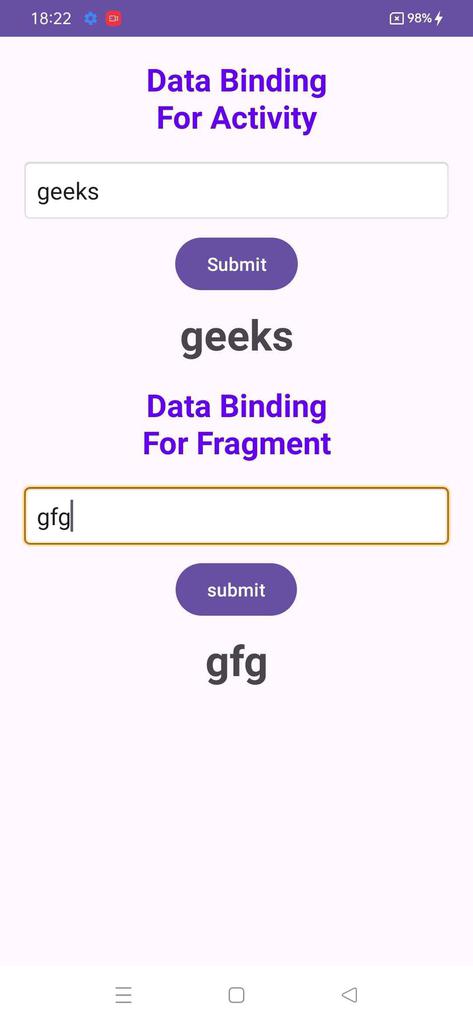|
In Android, the Data Binding Library is a support library that allows you to bind UI components in your layouts to data sources in your app using a declarative format rather than programmatically.
What we are going to build in this article?Here is a sample video of what we are going to build in this project. Note that we are going to make this project in Java language.
Step-by-Step ImplementationStep 1: Create a New Project- Open a New Project.
- We will be working on Empty Activity with language such as Java. Leave all other options unchanged.
- Name the application at your convenience.
- There will be two default files named activity_main.xml and MainActivity.java.
If you don’t know how to create a new project in Android Studio then you can refer to How to Create/Start a New Project in Android Studio?
Step 2. Enable DataBindingNavigate to Gradle Scripts > gradle.scripts(module) and add the following code to it.

Add the below code snippet to the build.gradle file to activate dataBinding in the application:
buildFeatures
{
dataBinding = true
}
Step 3. Working on XML filesNavigate to the app > res > layout > activity_main.xml and add the below code to that file.

Below is the code for the activity_main.xml file.
activity_main.xml
<?xml version="1.0" encoding="utf-8"?>
<layout xmlns:android="http://schemas.android.com/apk/res/android"
xmlns:app="http://schemas.android.com/apk/res-auto"
xmlns:tools="http://schemas.android.com/tools">
<LinearLayout
android:layout_width="match_parent"
android:orientation="vertical"
android:padding="16dp"
android:layout_height="match_parent"
tools:context=".MainActivity">
<TextView
android:layout_width="match_parent"
android:layout_height="wrap_content"
android:text="Data Binding\nFor Activity"
android:textSize="24sp"
android:textStyle="bold"
android:textColor="@color/design_default_color_primary"
android:gravity="center" />
<EditText
android:layout_width="match_parent"
android:layout_height="wrap_content"
android:id="@+id/et_input"
android:hint="Enter text"
android:padding="12dp"
android:layout_marginTop="16dp"
android:background="@android:drawable/editbox_background" />
<Button
android:layout_width="wrap_content"
android:layout_height="wrap_content"
android:id="@+id/bt_submit"
android:text="Submit"
android:layout_gravity="center"
android:layout_marginTop="8dp" />
<TextView
android:layout_width="match_parent"
android:layout_height="wrap_content"
android:id="@+id/tv_output"
android:textSize="32sp"
android:textStyle="bold"
android:gravity="center"
android:layout_marginTop="8dp" />
<FrameLayout
android:layout_width="match_parent"
android:layout_height="match_parent"
android:id="@+id/fragment"
android:layout_marginTop="16dp" />
</LinearLayout>
</layout>
Navigate to app > right-click > new > fragment > BlankFragment and name it as “MainFragement”:

Use the following code in fragment_main.xml file:
fragment_main.xml
<?xml version="1.0" encoding="utf-8"?>
<layout xmlns:android="http://schemas.android.com/apk/res/android"
xmlns:tools="http://schemas.android.com/tools">
<LinearLayout
android:layout_width="match_parent"
android:orientation="vertical"
android:gravity="center_horizontal"
android:layout_height="match_parent"
tools:context=".MainFragment">
<TextView
android:layout_width="match_parent"
android:layout_height="wrap_content"
android:text="Data Binding\nFor Fragment"
android:textSize="24sp"
android:textStyle="bold"
android:textColor="@color/design_default_color_primary"
android:gravity="center" />
<EditText
android:layout_width="match_parent"
android:layout_height="wrap_content"
android:id="@+id/et_input"
android:hint="Enter text"
android:padding="12dp"
android:layout_marginTop="16dp"
android:background="@android:drawable/editbox_background" />
<Button
android:layout_width="wrap_content"
android:layout_height="wrap_content"
android:id="@+id/bt_submit"
android:text="submit"
android:layout_marginTop="8dp" />
<TextView
android:layout_width="match_parent"
android:layout_height="wrap_content"
android:id="@+id/tv_output"
android:textSize="32sp"
android:textStyle="bold"
android:gravity="center"
android:layout_marginTop="8dp" />
</LinearLayout>
</layout>
Step 4. Working on Java filesNavigate to the MainActivity.java file and use the following code in it. Comments are added to the code to have a better understanding.
MainActivity.java
package com.example.databinding;
import androidx.appcompat.app.AppCompatActivity;
import androidx.databinding.DataBindingComponent;
import androidx.databinding.DataBindingUtil;
import androidx.fragment.app.Fragment;
import android.os.Bundle;
import android.view.View;
import android.widget.Toast;
import com.example.databinding.databinding.ActivityMainBinding;
public class MainActivity extends AppCompatActivity {
// Initialize variables
ActivityMainBinding binding;
@Override
protected void onCreate(Bundle savedInstanceState) {
super.onCreate(savedInstanceState);
// Assign variable
binding= DataBindingUtil.setContentView(this,R.layout.activity_main);
binding.btSubmit.setOnClickListener(new View.OnClickListener() {
@Override
public void onClick(View view) {
// Get text from edit text
String sText=binding.etInput.getText().toString().trim();
// Check condition
if(!sText.equals(""))
{
// when text is not empty
// set text on text view
binding.tvOutput.setText(sText);
}
else
{
// When text is empty
// Display Toast
Toast.makeText(getApplicationContext()
,"Please enter text",Toast.LENGTH_SHORT).show();
}
}
});
// Initialize fragment
Fragment fragment=new MainFragment();
// Commit fragment
getSupportFragmentManager().beginTransaction()
.replace(R.id.fragment,fragment).commit();
}
}
Navigate to the MainFragment.java file and use the following code in it.

Comments are added to the code to have a better understanding.
MainFragment.java
package com.example.databinding;
import android.os.Bundle;
import androidx.databinding.DataBindingUtil;
import androidx.fragment.app.Fragment;
import android.view.LayoutInflater;
import android.view.View;
import android.view.ViewGroup;
import android.widget.Toast;
import com.example.databinding.databinding.FragmentMainBinding;
public class MainFragment extends Fragment {
// Initialize variable
private FragmentMainBinding binding;
private View view;
private static final String ARG_PARAM1 = "param1";
private static final String ARG_PARAM2 = "param2";
private String mParam1;
private String mParam2;
public MainFragment() {
// Required empty public constructor
}
public static MainFragment newInstance(String param1, String param2) {
MainFragment fragment = new MainFragment();
Bundle args = new Bundle();
args.putString(ARG_PARAM1, param1);
args.putString(ARG_PARAM2, param2);
fragment.setArguments(args);
return fragment;
}
@Override
public void onCreate(Bundle savedInstanceState) {
super.onCreate(savedInstanceState);
if (getArguments() != null) {
mParam1 = getArguments().getString(ARG_PARAM1);
mParam2 = getArguments().getString(ARG_PARAM2);
}
}
@Override
public View onCreateView(LayoutInflater inflater, ViewGroup container,
Bundle savedInstanceState) {
// Assign variable
binding= DataBindingUtil.inflate(inflater,R.layout.fragment_main,container,false);
view=binding.getRoot();
binding.btSubmit.setOnClickListener(new View.OnClickListener() {
@Override
public void onClick(View view) {
// Get text from edit text
String sText=binding.etInput.getText().toString().trim();
// Check condition
if(!sText.equals(""))
{
// When text is not empty
// Set text on text view
binding.tvOutput.setText(sText);
}
else
{
// When text is empty
// Display Toast
Toast.makeText(view.getContext(),
"Please enter text",Toast.LENGTH_SHORT).show();
}
}
});
// Return view
return view;
}
}
Here is the final output of our application.
Output:

|





